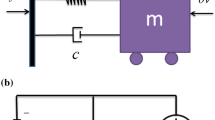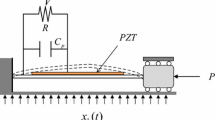Abstract
A fractionally damped vibration energy harvester excited by the wide-band random noise is investigated theoretically in this paper. Firstly, by introducing the generalized harmonic transformation, an equivalent uncoupled system only with respect to the mechanical states is established, while the external circuit and the fractional derivative damping are decoupled into damping and stiffness with amplitude-dependent coefficients, respectively. Then, a stochastic averaging operator technique is carried out to derive the stationary distribution of the mechanical states and furtherly obtain the mean square electric voltage (MSEV) and mean output power (MOP) of the energy harvester theoretically. Finally, the relationships between the fractional derivative and the MSEV and MOP are explored in detail to help improve the performance of the energy harvester.











Similar content being viewed by others
References
Vinogradov, A.M., Schmidt, V.H., Tuthill, G.F., Bohannan, G.W.: Damping and electromechanical energy losses in the piezoelectric polymer PVDF. Mech. Mater. 36(10), 1007–1016 (2003)
Cepnik, C., Lausecker, R., Wallrabe, U.: Review on electrodynamic energy harvesters-a classification approach. Micromachines 4(2), 168–196 (2013)
Zhou, S., Cao, J., Inman, D.J., Lin, J., Liu, S., Wang, Z.: Broadband tristable energy harvester: modeling and experiment verification. Appl. Energy 133, 33–39 (2014)
Shu, Y.C., Lien, I.C.: Analysis of power output for piezoelectric energy harvesting systems. Smart Mater. Struct. 15(6), 1499–1512 (2006)
Erturk, A., Inman, D.J.: Introduction to Piezoelectric Energy Harvesting. Wiley, United Kingdom (2011)
Wang, X.F., Wei, X.Y., Pu, D., Huan, R.H.: Single-electron detection utilizing coupled nonlinear microresonators. Microsyst. Nanoeng. 6(1), 327–333 (2020)
Wang, X.F., Huan, R.H., Zhu, W.Q., Pu, D., Wei, X.Y.: Frequency locking in the internal resonance of two electrostatically coupled micro-resonators with frequency ratio 1:3. Mech. Syst. Signal Process. 146, 106981 (2021)
Kumar, G.S., Prasad, G.: Piezoelectric relaxation in polymer and ferroelectric composites. J. Mater. Sci. 28, 2545–2550 (1993)
Kwuimy, C.A.K., Litak, G., Nataraj, C.: Nonlinear analysis of energy harvesting systems with fractional order physical properties. Nonlinear Dyn. 80, 491–501 (2015)
Hartley, T.T., Lorenzo, C.F.: A frequency-domain approach to optimal fractional-order damping. Nonlinear Dyn. 38, 69–84 (2004)
Maia, N.M.M., Silva, J.M.M., Ribeiro, A.M.R.: On a general model for damping. J. Sound Vib. 218(5), 749–767 (1998)
Rossikhin, Y.A., Shitikova, M.V.: Applications of fractional calculus to dynamic problems of linear and nonlinear hereditary mechanics of solids. Appl. Mech. Rev. 50(1), 15–67 (1997)
Machado, J.T., Kiryakova, V., Mainardi, F.: Recent history of fractional calculus. Commun. Nonlinear Sci. 16(3), 1140–1153 (2010)
Li, Z., Liu, L., Dehghan, S., Chen, Y., Xue, D.: A review and evaluation of numerical tools for fractional calculus and fractional order controls. Int. J. Control 90(6), 1165–1181 (2016)
Rossikhin, Y.A., Shitikova, M.V.: Application of fractional calculus for dynamic problems of solid mechanics: novel trends and recent results. Appl. Mech. Rev. 63(1), 010801 (2010)
Cao, J., Zhou, S., Inman, D.J., Chen, Y.: Chaos in the fractionally damped broadband piezoelectric energy generator. Nonlinear Dyn. 80(4), 1705–1719 (2015)
Cao, J., Syta, A., Litak, G., Zhou, S., Inman, D.J., Chen, Y.: Regular and chaotic vibration in a piezoelectric energy harvester with fractional damping. Eur. Phys. J. Plus 130(6), 103 (2015)
McInnes, C.R., Gorman, D.G., Cartmell, M.P.: Enhanced vibrational energy harvesting using nonlinear stochastic resonance. J. Sound Vib. 318(4–5), 655–662 (2008)
Daqaq, M.F.: Transduction of a bistable inductive generator driven by white and exponentially correlated Gaussian noise. J. Sound Vib. 330(11), 2554–2564 (2010)
Green, P.L., Worden, K., Atallah, K., Sims, N.D.: The benefits of duffing-type nonlinearities and electrical optimisation of a mono-stable energy harvester under white Gaussian excitations. J. Sound Vib. 331(20), 4504–4517 (2012)
Chen, L., Zhao, T., Li, W., Zhao, J.: Bifurcation control of bounded noise excited duffing oscillator by a weakly fractional-order PIλDμ feedback controller. Nonlinear Dyn. 83(1–2), 529–539 (2016)
Huang, Z.L., Jin, X.L.: Response and stability of a SDOF strongly nonlinear stochastic system with light damping modeled by a fractional derivative. J. Sound Vib. 319(3–5), 1121–1135 (2008)
Paola, M.D., Failla, G., Pirrotta, A.: Stationary and non-stationary stochastic response of linear fractional viscoelastic systems. Probabilist. Eng. Mech. 28(SI), 85–90 (2012)
Xu, M., Jin, X., Wang, Y., Huang, Z.L.: Stochastic averaging for nonlinear vibration energy harvesting system. Nonlinear Dyn. 78(2), 1451–1459 (2014)
Xu, M., Li, X.: Stochastic averaging for bistable vibration energy harvesting system. Int. J. Mech. Sci. 141, 206–212 (2018)
Jin, X., Wang, Y., Xu, M., Huang, Z.: Semi-analytical solution of random response for nonlinear vibration energy harvesters. J. Sound Vib. 340, 267–282 (2015)
Jiang, W.A., Chen, L.Q.: An equivalent linearization technique for nonlinear piezoelectric energy harvesters under Gaussian white noise. Commun. Nonlinear Sci. 19(8), 2897–2904 (2014)
Jiang, W.A., Chen, L.Q.: Stochastic averaging of energy harvesting systems. Int. J. Nonlin. Mech. 85, 174–187 (2016)
Jiang, W.A., Chen, L.Q.: Stochastic averaging based on generalized harmonic functions for energy harvesting systems. J. Sound Vib. 377, 264–283 (2016)
Zhu, H.T.: Probabilistic solution of non-linear vibration energy harvesters driven by Poisson impulses. Probabilist. Eng. Mech. 48, 12–26 (2017)
Ghouli, Z., Hamdi, M., Lakrad, F., Belhaq, M.: Quasiperiodic energy harvesting in a forced and delayed Duffing harvester device. J. Sound Vib. 407, 271–285 (2017)
Litak, G., Borowiec, M., Friswell, M.I., Adhikari, S.: Energy harvesting in a magnetopiezoelastic system driven by random excitations with uniform and Gaussian distributions. J. Theor. Appl. Mech. 49(3), 757–764 (2011)
Litak, G., Friswell, M.I., Adhikari, S.: Magnetopiezoelastic energy harvesting driven by random excitations. Appl. Phys. Lett. 96(21), 214103 (2010)
Liu, D., Xu, Y., Li, J.: Probabilistic response analysis of nonlinear vibration energy harvesting system driven by Gaussian colored noise. Chaos Soliton. Fract. 104, 806–812 (2017)
Liu, D., Xu, Y., Li, J.: Randomly-disordered-periodic-induced chaos in a piezoelectric vibration energy harvester system with fractional-order physical properties. J. Sound Vib. 399, 182–196 (2017)
Yang, Y.G., Xu, W.: Stochastic analysis of monostable vibration energy harvesters with fractional derivative damping under Gaussian white noise excitation. Nonlinear Dyn. 94(1), 639–648 (2018)
Xu, Z., Cheung, Y.K.: Averaging method using generalized harmonic functions for strongly non-Linear oscillators. J. Sound Vib. 174(4), 563–576 (1994)
Khasminskii, R.Z.: A Limit theorem for the solution of differential equations with random right-hand sides. Theor. Probab. Appl. 11(3), 390–406 (1966)
Kushner, H.J.: Approximation and Weak Convergence Methods for Random Processes, with Applications to Stochastic Systems Theory. The MIT Press, London (1984)
Funding
This work was supported by the Natural Science Foundation of China through the Grant Nos. 11972293, 11872307.
Author information
Authors and Affiliations
Corresponding author
Ethics declarations
Conflict of interest
The authors declare that they have no conflict of interest.
Data availability
The raw/processed data required to reproduce these findings cannot be shared at this time as the data also forms part of an ongoing study.
Additional information
Publisher's Note
Springer Nature remains neutral with regard to jurisdictional claims in published maps and institutional affiliations.
Appendix
Appendix
1.1 Appendix A: The averaging of the fractional derivative damping
Due to A and ϕ are slow variables, the following approximate relation can be obtained by Eq. (9):
Using Eq. (36), the averaging of the term associated with fractional derivative of Eq. (16) can be simplified as follows:
In Eqs. (37) and (38), A is treated as a constant since it varies slowly. To simplify Eqs. (37) and (38) furtherly, the following asymptotic integrals can be applied:
Substituting Eqs. (39)–(40) into Eqs. (37)–(38), and completing the averaging can lead to
1.2 Appendix B: The simulation of the fractional derivative damping and wide-band noises
(i). The definition of the fractional derivative in Eq. (2) could be reformulated as:
Thus, the following numerical integration can be employed with the initial condition \(D^{\alpha } \overline{X}\left( 0 \right) = \dot{\overline{X}}_{0}\) given in Ref. [14],
(ii). To generate the samples of independent wide-band noises \(\xi_{i} (t)\), the following second-order linear filters can be adopted:
where \(W_{i} (t)\) denote the independent Gaussian white noises with intensities \(D_{i}\).
Rights and permissions
About this article
Cite this article
Hu, R., Zhang, D., Deng, Z. et al. Stochastic analysis of a nonlinear energy harvester with fractional derivative damping. Nonlinear Dyn 108, 1973–1986 (2022). https://doi.org/10.1007/s11071-022-07338-1
Received:
Accepted:
Published:
Issue Date:
DOI: https://doi.org/10.1007/s11071-022-07338-1




